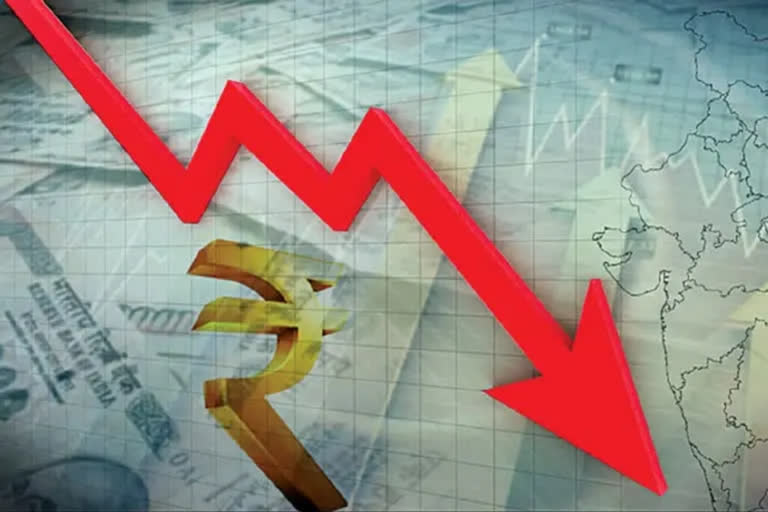New Delhi: India's economic growth slowed to 4.4 per cent in the December quarter on continued weakness in the manufacturing sector and rising borrowing costs hurting demand, ahead of a crisis at Adani group and predictions of a hot summer.
While the growth was lower than the market estimate of 4.7 per cent, the GDP growth for FY22 (April 2021 to March 2022) has been revised to a higher at 9.1 per cent (from 8.7 per cent) and has consequently led to a major change in the base factor. The slowdown came ahead of turbulence in the capital and financial markets witnessed following allegations of fraud in the Adani Group and the prediction of a hot summer. Adani group has denied all allegations.
The government, however, continues to be confident about touching a GDP growth of 7 per cent for FY23 (April 2022 to March 2023) as a whole. Asia's third-largest economy recorded year-on-year growth of 4.4 per cent in October-December, down from 11.2 per cent a year back and 6.3 per cent in the preceding quarter, according to data released by the National Statistical Office (NSO) on Tuesday.
Manufacturing output shrank by 1.1 per cent in October-December, the second straight contraction reflecting weakness in consumer demand and exports. One reason was weak external demand as central banks globally continued monetary tightening to tame inflation. The Reserve Bank of India (RBI) has raised its benchmark repo rate by 250 basis points since May last year with expectations of another 25 basis points hike to 6.75 per cent in April before hitting pause until year-end.
The loss in growth momentum witnessed since the July-September quarter was mainly on account of fading away of the favourable base effect, a slowdown in pent-up demand due to high inflation and interest rates, and a contraction in manufacturing sectors. Low private consumption coupled with lower government spending were also the reasons. The lack of momentum in rural demand and weakness in exports was partly offset by the steady demand for goods and services in the urban economy. Trade, transport, construction, and other services grew between 8.4 per cent and 9.7 per cent, a part of which can be attributed to pent-up demand after the dissolution of the Covid threat, the data showed.
Commenting on the GDP numbers, Chief Economic Advisor V Anantha Nageswaran said India needs to grow at 4 per cent in the March quarter to achieve a 7 per cent real GDP growth rate for the full fiscal. While there are enough signs that manufacturing is in good health, India has to be prepared to deal with El Nino and weather-related uncertainties, he said. "The trends that we have in terms of high-frequency data for 2022-23 for the fourth quarter do indicate that achieving that (4-4.1 per cent) growth rate in Q4 is well within the realm of possibility and therefore the 7 per cent real GDP growth estimate for 2022-23 is very realistic."
The Finance Ministry's Economic Survey has projected economic growth to be 6.5 per cent in the 2023-24 fiscal beginning April 2023, compared to a 7 per cent estimated growth in FY23 and a revised 9.1 per cent expansion in 2021-22. Downside risks dominate the 6.5 per cent growth forecast, Nageswaran said, adding "no big ticker shock is expected in the next fiscal". The projection for the current fiscal is in line with the 7 per cent forecast of the Asian Development Bank (ADB) while a tad higher than the International Monetary Fund's (IMF) prediction of 6.8 per cent GDP growth in 2022-23.
"Going ahead into the next fiscal however, the factors that will play an important role are the impact of higher interest rates on urban demand, the stability of the monsoon, and the absence of the base factor; we have kept our GDP growth forecast for FY24 at 6 per cent for now without factoring in any additional risks from monsoon and external factors," said Suman Chowdhury, Chief Analytical Officer, Acuit Ratings & Research.
DK Srivastava, Chief Economic Advisor, EY India, said the revisions announced on Tuesday also indicate a reassessment of the contraction in the Covid year of 2020-21. The negative growth in that year is now assessed at (-)5.7 per cent which is much lower than its first provisional estimate at (-)7.3 per cent. "Thus, the cumulated average real GDP growth rate over the period 2019-20 to 2022-23 is 3.2 per cent. From a long-term viewpoint, Covid has caused a reduction of nearly 4 per cent points as compared to the potential growth of 7 per cent," Srivastava said. (PTI)
